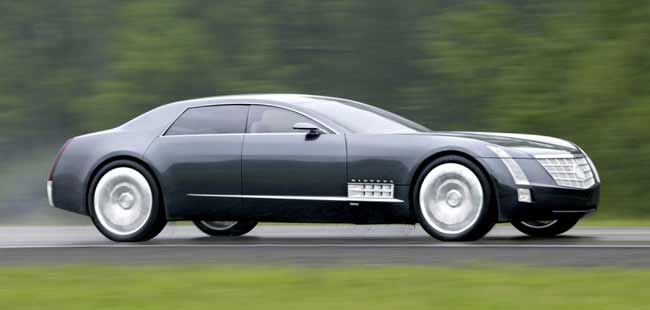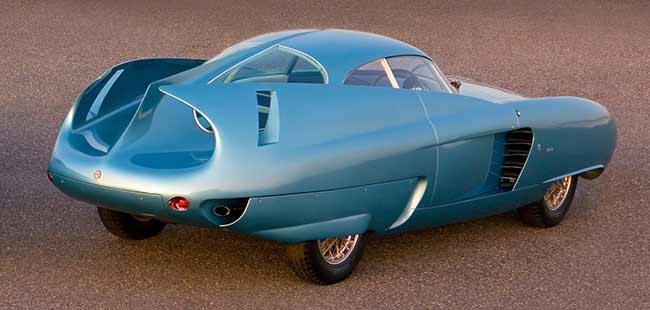Concept cars that never made it to production

Designers all over the world have imagined the way a car looks and though this creativity might very easily pour out on paper, to get them translated into full-fledged production versions is quite a task. The convincing part is the biggest deal breaker for most concepts.
Some of the designs we get to see as concepts in Auto Shows across the globe and we manage to show our appreciation at the effort put into making this sketch a concept. But any amount of coaxing will not get the manufacturer to bring out a production version of it. We trace down a few that we can remember, to tell you what you have missed to see on roads. Had they seen the light of the assembly line; things would have been different.
Cadillac Sixteen
The Cadillac Sixteen was a car which was brought out and showcased in 2003, when General Motors was overflowing with profits and was a way to celebrate and tell the people about the future of the company, the Sixteen was the most ideal way to say that.
The Sixteen was made entirely of aluminium and had a low slung profile. Lookswise GM had it sorted but there was more. The name 'Sixteen' came from the car's powerful 16-cylinder, 1000bhp engine. It got the royal treatment too as it was dressed with silk carpets, a crystal Bulgari clock, smoked-glass roof and a chilled-champagne compartment. All this was a way of bringing back memories from the 30's when Cadillac first developed their V16.
It is said that the Sixteen was a dream project of the then Vice Chairman of GM Robert Lutz, but eventually the idea had to be scrapped due to budget constraints.

Alfa Romeo B. A. T
The B. A. T short for Berlinetta Aerodinamica Tecnica, was a car thatwas given birth thanks to thejoint collaboration project between Alfa Romeo and the Italian design house Bertone in 1953. The alfa Romeo B.A.T made its public debut at the Turin Motor Show in 1953 and was called the BAT 5. Two more cars would join this badge of cars soon the BAT 5 and the BAT 7 but neither saw the light of production. All three cars were designed by Franco Scaglione.
The BAT was a model built to study the aerodynamics. The front has been designed to eliminate the problem of airflow disruption at high speeds. It was all about flowing with the air and doing all of this with equal ease. Alfa Romeo had put under the hood of this car a 100bhp monster which would allow, thanks to the construction of the car, a speed of 200km/h.
The BAT was light too and weighed in at 1100 kgs. The design was among the most popular cars back then but it was the rear that surprised most. The length-ways rear windscreen divided by a slim pillar, and the two fins tapering upwards and slightly inwards. So, even the aesthetic sense was very much maintained. Though it got the approval of the crowd and got three versions to its name, there was no production version of it.

Chevrolet Aerovette
The Chevrolete Aerovette was a beauty when we first got to see it in the 1970's. The car was built by the Chevrolet design team to test it out for high performance. But the Aerovette was stunning and everyone expected it to be next in line for production from the GM stable.
The Aerovette displayed a strongly triangulated "mound" shape, and was extremely balanced when it came to proportions. The gullwing doors brought back memories of the Mercedes 300SL and were designed to get out of tight parking spots (well that was the practical explanation).
The interior was fully engineered than the typical concept car which is one reason why everyone thought the Aerovette would, one day, see the light of production. The mid-engined car would be capable of producing close to 420bhp while transmission duties were handled by a four-speed manual and three-speed Turbo Hydra-Matic.
The talk around town was it will be up for sale but it never happened. Some say it was a management move and others say it was because there was a change in management. Whatever, the reason, the lay man has not been able to succumb to the charm of what may have been one of the most loved sports cars of all times.
Trending News
 1 min readTriumph Tracker 400: In Pictures
1 min readTriumph Tracker 400: In Pictures 1 min readTriumph Tracker 400 Unveiled in UK
1 min readTriumph Tracker 400 Unveiled in UK
Latest News
 Jafar Rizvi | Dec 18, 2025Tata Sierra Pure, Pure+ Variants Explained In PicturesThe Pure trim of the Sierra is priced from Rs 12.49 lakh to Rs 17.49 lakh (ex-showroom), depending on the powertrain option. Here is a breakdown of what it gets.1 min read
Jafar Rizvi | Dec 18, 2025Tata Sierra Pure, Pure+ Variants Explained In PicturesThe Pure trim of the Sierra is priced from Rs 12.49 lakh to Rs 17.49 lakh (ex-showroom), depending on the powertrain option. Here is a breakdown of what it gets.1 min read Janak Sorap | Dec 17, 2025Triumph Tracker 400: In PicturesTriumph has unveiled the new Tracker 400 based on the Speed 400. Here’s a quick look at the motorcycle in pictures.1 min read
Janak Sorap | Dec 17, 2025Triumph Tracker 400: In PicturesTriumph has unveiled the new Tracker 400 based on the Speed 400. Here’s a quick look at the motorcycle in pictures.1 min read Jaiveer Mehra | Dec 17, 2025Tata Sierra Smart Plus Revealed In Official Pictures: What Do You Get For Rs 11.49 Lakh?While nearly everyone has seen the Sierra in pictures and many in person at dealerships, you’ll likely only have seen the top models. But what is the base variant like?2 mins read
Jaiveer Mehra | Dec 17, 2025Tata Sierra Smart Plus Revealed In Official Pictures: What Do You Get For Rs 11.49 Lakh?While nearly everyone has seen the Sierra in pictures and many in person at dealerships, you’ll likely only have seen the top models. But what is the base variant like?2 mins read car&bike Team | Dec 17, 20252025 Ducati Panigale V2, Streetfighter V2 Recalled In The USThe recall states that two ABS fuses may have been inadvertently fitted in the wrong positions during wiring assembly and could increase the risk of a crash.3 mins read
car&bike Team | Dec 17, 20252025 Ducati Panigale V2, Streetfighter V2 Recalled In The USThe recall states that two ABS fuses may have been inadvertently fitted in the wrong positions during wiring assembly and could increase the risk of a crash.3 mins read Jafar Rizvi | Dec 17, 2025Updated Bajaj Pulsar 220F Does Not Get Dual-Channel ABS; Company Issues ClarificationBajaj Auto has confirmed that the updated Pulsar 220F does not feature dual-channel ABS, contradicting earlier reports.1 min read
Jafar Rizvi | Dec 17, 2025Updated Bajaj Pulsar 220F Does Not Get Dual-Channel ABS; Company Issues ClarificationBajaj Auto has confirmed that the updated Pulsar 220F does not feature dual-channel ABS, contradicting earlier reports.1 min read Janak Sorap | Dec 16, 2025Triumph Tracker 400 Unveiled in UKBased on the Speed 400’s platform with the tune from the Thruxton 400.1 min read
Janak Sorap | Dec 16, 2025Triumph Tracker 400 Unveiled in UKBased on the Speed 400’s platform with the tune from the Thruxton 400.1 min read
 Janak Sorap | Dec 11, 2025Harley-Davidson X440 T First Ride Review: Smarter and SharperHarley-Davidson has taken the X440 and given it a more focused and engaging twist. The result is the X440 T—essentially the same platform but updated in areas that give the motorcycle more appeal and riders more thrill.5 mins read
Janak Sorap | Dec 11, 2025Harley-Davidson X440 T First Ride Review: Smarter and SharperHarley-Davidson has taken the X440 and given it a more focused and engaging twist. The result is the X440 T—essentially the same platform but updated in areas that give the motorcycle more appeal and riders more thrill.5 mins read Shams Raza Naqvi | Dec 10, 20252025 Mini Cooper Convertible Review: More Colour On Indian RoadsThe updated Mini Cooper Convertible is set to be launched in the Indian market in the next few days. We drive it around Jaisalmer for a quick review.1 min read
Shams Raza Naqvi | Dec 10, 20252025 Mini Cooper Convertible Review: More Colour On Indian RoadsThe updated Mini Cooper Convertible is set to be launched in the Indian market in the next few days. We drive it around Jaisalmer for a quick review.1 min read Bilal Firfiray | Dec 8, 2025Tata Sierra Review: India’s New Favourite?Marking its return after a few decades, the reborn Sierra has made everyone sit up and take notice. But is it worth the hype?10 mins read
Bilal Firfiray | Dec 8, 2025Tata Sierra Review: India’s New Favourite?Marking its return after a few decades, the reborn Sierra has made everyone sit up and take notice. But is it worth the hype?10 mins read Girish Karkera | Dec 4, 20252026 Honda Prelude First Drive: Domesticated Civic Type RA sporty-looking coupe built to give customers a taste of performance but not at the expense of everyday practicality.5 mins read
Girish Karkera | Dec 4, 20252026 Honda Prelude First Drive: Domesticated Civic Type RA sporty-looking coupe built to give customers a taste of performance but not at the expense of everyday practicality.5 mins read Seshan Vijayraghvan | Nov 29, 2025Mahindra XEV 9S First Drive Review: Big Electric SUV, Bigger ExpectationsThe XEV 9S lands at a time when the EV crowd is growing fast. It’s a big, born-electric, three-row SUV that starts under 20 lakh. It sits close to the XUV700 in size, but the brief is very different. Here’s what it’s like on the road.11 mins read
Seshan Vijayraghvan | Nov 29, 2025Mahindra XEV 9S First Drive Review: Big Electric SUV, Bigger ExpectationsThe XEV 9S lands at a time when the EV crowd is growing fast. It’s a big, born-electric, three-row SUV that starts under 20 lakh. It sits close to the XUV700 in size, but the brief is very different. Here’s what it’s like on the road.11 mins read































































































































